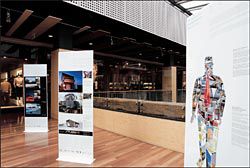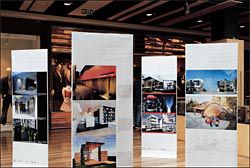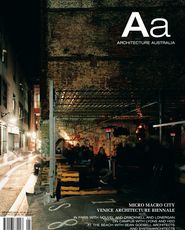PHOTOGRAPHY Mark Munro
Katelin Butler considers an exhibition of the work of twenty-seven “young” Victorian practices, which was recently displayed at Melbourne Central.

Rexroth Mannasmann Collective’s display, with panels by Peter Woolard Studio101 Architects and Whitefield McQueen Architects in the background.

Work by Kennedy Nolan, Matt Gibson A+D, By Architects, and Cassandra Complex, seen from left to right.
Where is architecture going and who will be at the forefront of the architectural profession in years to come? Twenty-seven emerging Victorian architectural practices have been exposed to the general public in an exhibition based on the theme Past + Present + Future. The participating practices were those seen to “pop up” in the architectural scene over the last seven years. A diverse selection of work was on display, through which contemporary architectural preoccupations were introduced. Each practice represented three of their projects on a single panel. The way we think about architecture was challenged, with each firm hoping to make their mark on architectural culture.
The quality of the work was varied, with some projects more appealing than others.
Perhaps one of the most interesting aspects, and the most informative in relation to where architecture is going, is how each practice dealt with the idea of “the future”.
The young practices’ long-term architectural aspirations were unveiled to the public eye. Jackson Clements Burrows, for example, used a three-dimensional montage to portray a building on the moon.
Looking to solve the problems of the future relating to sustainability is of concern to many of the young practices, notably Phooey, who aim to “produce zero waste and architecture that may embrace the sobriety of global warming”. Bent Architecture presented projects that were inextricably linked to changing the way we think about suburban Melbourne, exploring the problem of future social housing. Minifie Nixon’s proposal “Evolute”, winner of the City of Skyscrapers Competition, Ljubljana Biennale 2005, involved no preconceptions about what architecture should be, and again invited the audience to think in unconventional ways. Buro Architects displayed their design for “sky bar”, a modern extension of a neoclassical building in the French concession area in Shanghai. The hopefulness of the ambitious “young” practices is inspiring, especially considering not all the practitioners are actually young themselves.
The panel layouts were personalized to suit the different practitioners. ODR took the idea of promotion towards the public literally, with each image presented with a price tag. To affirm their interest in making a stir, ODR also included snippets of text from both clients and those who object to their buildings. The Rexroth Mannasmann Collective arranged their images into the shape of a plump businessman, which perhaps represented the fictitious architectural figurehead of the practice itself. A more conservative but elegant presentation from Studio505 explored lyrical expressions of facade form. Among these exciting displays, it was disappointing to see a lack of depth in a couple of the other presentations.
The staging of the exhibition was significant, as it is always difficult to attract a public audience to an architectural exhibition. Presented at Melbourne Central, fittingly designed by a well-established Victorian architectural practice, the exhibition became part of the public arena.
On a busy Saturday morning, many meandering passers-by stopped to have a look at what the panels were all about.
Unfortunately cost restraints meant the panels were presented on flimsy stands, which were not suited to a vulnerable public place. In the spirit of promotion, one of the practices left business cards for people to take with them.
Passion for architecture was evident in this cross-section of young practices and such an exhibition is a welcome celebration of the up-and-coming era of architecture itself. Pushing the boundaries of design and dealing with the environmental issues of today, the future of the built environment looks promising.KATELIN BUTLER IS EDITORIAL ASSISTANT FOR ARCHITECTURE AUSTRALIA.















